In order to assist travellers wishing to visit the Roman sites within the Bay of Naples area, using public transport, we have included brief directions to help you to find these sites using the excellent local rail services which operate in the area.
Disclaimer: This information is submitted by our members and is updated from time to time. We do our best to ensure its accuracy but it can change without warning and the Friends of Herculaneum accept no responsibility for such amendments. We advise users to check at all times with local authorities.
Herculaneum
Why visit Herculaneum?
Herculaneum was a peaceful seaside town which was struck by a succession of pyroclastic flows during the eruption of Vesuvius in AD 79. It was covered with 20 metres of a mixture of the pyroclastic material and volcanic mud. Approximately one third of the town has been excavated. It is notable for the relatively high standard of preservation of the houses and the public baths. A significant number of high quality painted walls may be seen. The roman sea shore has been exposed during the excavations and a roman boat has been preserved in a special museum. In 2022 an impressive exhibition was also created showing some of the jewellery and other artworks which were found during the excavations.
How to get there
Use the Circumvesuviana train service to go to the station named Ercolano Scavi.
From the train station
On leaving the station you will find yourself in a small car filled piazza, the exit is diagonally towards your right. Beyond this exit there is a roundabout with a fountain and a broad road descends downhill, towards the sea, for about 200 metres. It ends at a T-junction. Proceed to the T-junction. Beyond the T-junction, immediately opposite the road that you have descended, is a large white gateway, proceed through the gateway to the excavations. The ticket office is approximately 100 metres beyond the white gateway. Basic maps and guides are available at the ticket office, there is also a bookshop which is accessible from the ticket office.
Travellers by car should locate the car park for the site which is to the south of the archeological site.
A summary of the train services is available.
The Ferrovia dello Stato alternative train service
The Ferrovia dello Stato is the state run railway and, at the time of writing, it is branded as Ferrovia with a lower case ‘f’ being the logo.
It is possible to get to Herculaneum from Naples (or Salerno) using the Ferrovia, the service runs from Campi Flegrei to Salerno and uses the Metro Line 2 for part of its journey. Whilst it is a long walk from the Ferrovia railway station for Ercolano to the excavations it has the advantage for those staying in Naples and close to the relevant stations that there is no need to change at Naples Garibaldi station. The service runs roughly every half hour but it is essential to use the timetable because some trains are omitted and sometimes there are three trains per hour.
A method of finding the train times is included in the trains section of this website.
On leaving the station at Ercolano you will climb a short flight of steps and see an apartment block directly ahead of you across a paved pedestrian area which is cut by two narrow roads. To the right of the apartment block is a stone wall with a fence on top. Follow this wall to the right, the pavement is on the opposite side of the street and, in a short while you will see the Bourbon Royal Palace across an extensive area of grass. Take the first left after the Royal Palace, the road is called Via Roma but the nameplate is not immediately visible being on the side of the road from which you are approaching. This road climbs steadily for a significant distance to reach a T junction at Corso Resina. Turn right onto Corso Resina and proceed slightly downhill until you see the white entrance gateway to the excavations on your right.
The author walked this route in June 2018 and took 22 minutes.
Last travelled
The author last completed the journeys described in June 2018.
Pompeii
Why should you go to Pompeii?
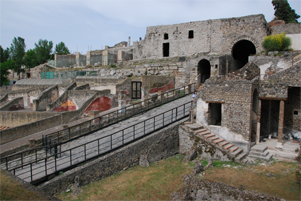
Pompeii was a Roman city which was struck by two pyroclastic flows during the eruption of Vesuvius in AD 79. These killed what remained of the population. The city was then covered by a thick layer of the material which was ejected by the volcano. It provides an opportunity to see an entire roman city with all of its services and a sample of the rows of tombs which lined all of the roads which left the city. Of particular note is the forum, with the forum baths and the basilica. The basilica served as a law court in roman cites.
There are two theatres and an amphitheatre. The amphitheatre has been described as the oldest permanent stone built amphitheatre existing from the roman world. The roads, with the road surface being well below the height of the pavement and with stepping stones at the junctions, provide one of the well known images of the ancient world. There is a suggestion that this was merely a response to the problem of conducting away excessive rainwater in a city on the edge of a hill rather than being typical of roman cities.
There are too many notable houses to itemise. The Villa of the Mysteries lies outside the city and is a fine example of a large Roman suburban villa.
Visitors using public transport will enter through the Marine Gate, guide books are available from a bookshop at this gate. The city is so large that a map is the minimum that is required. At the time of writing a map is included with a ticket purchased at the entrance. The same map is also available on the Pompeii website . The same website includes a brief but useful guide.
Pompeii has the highest number of visitors of any ancient site in Europe and it deserves that accolade.
How to get there
Use the Circumvesuviana train service to go to the station named Pompeii Scavi.
Turn right out of the station and, after 100 yards, left into the excavations.
A summary of the train services is available.
Last Travelled
The author last completed the journey described in June 2014.
Oplontis
Why should you go to Oplontis?
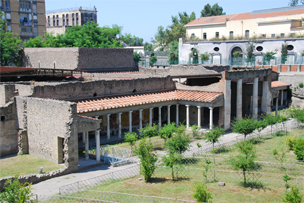
Oplontis is popularly believed to be the villa built by the Emperor Nero as a wedding present for his second wife, Poppea.
Poppea is understood to have been a member of the Sabina family which was a significant political force in Pompeii. The emperors had a number of houses in the area around Vesuvius and it seems likely that this building was a gift which would show her family the extent of Nero’s feelings for her rather than just being preferable to staying with the inlaws. It is magnificent.
The excavated area is only a small proportion of the range of buildings which would have made up the villa. The rooms are notable for their size and for the quality of decoration. The decorative styles are of interest as are the decorated light wells in the wing beside the swimming pool and the arrangement of the garden. The swimming pool is enormous.
The Sopraintendenza provides both a map and a guide to Oplontis.
How to get there
Use the Circumvesuviana train service to go to the station named Torre Annunziata.
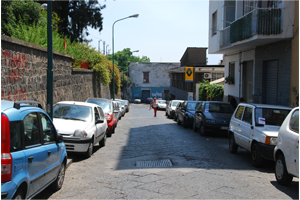
The main exit from the station is on the sea side. Turn left out of the station, walk 50 metres to the main road, turn right and walk downhill, crossing a main road. The Villa is a hundred metres beyond the main road. It is on your left and in a big hole in the ground. There are signs directing you to the excavations near the station but they are a bit thin on the ground after that.
This site does not have a car park.
A summary of the train services is available.
Last travelled
The author last completed the journey described in June 2014.
Boscoreale
Why should you go to Boscoreale?
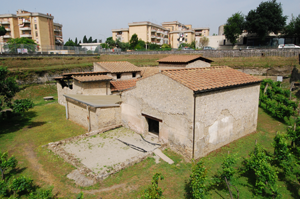
Villa Regina at Boscoreale is a Roman villa. The word villa is applied to large Roman country houses but originally meant a farm. Boscoreale is a working farm. It is a comfortable working farm rather than the bare minimum required but it is certainly not luxurious. It is possible to speculate that it was the sort of farm which might be owned by a resident of Pompeii and might be used as the equivalent of a weekend escape but it would still have employed staff and would have had to make a profit. The area immediately surrounding the farm was in Roman times, and still is, a vineyard. Vines have been planted in the holes left by the roots of the Roman vines. The facilities for processing the grapes to wine remain. Those who have been brought up in the countryside will find that the building has the comfortable feeling of a working farm.
At the end of 2022 the villa at Boscoreale was open but the Antiquarium was closed during refurbishment. You are advised to check whether it has been re-opened before visiting.
How to get there – revised route
In June 2017 EAV opened a new station to serve the community at Villa Regina. It also provides a means of reaching the site and museum with a much shorter walk than the route from Pompeii Station.
For a couple of years we will keep both of these routes on this website but the original route should become a historical anomaly. It is possible that some visitors to Pompeii may wish to take the Villa dei Misteri exit and to walk from there to Boscoreale using the original route from Via Diomede onwards. They may use the original instructions.
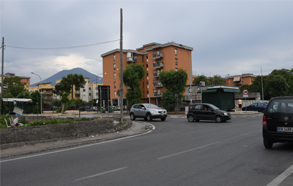
The train timetables for the Naples to Sorrento railway included Villa Regina from October 2017. The new station is located close to one of the main roads in Boscoreale. On leaving the station it will be seen that there is a new approach road to the station ahead of you, walk along this road until it joins the main road and then proceed for a further 100 metres when you will reach Viale Villa Regina. There is a sign to the site at this junction, turn left onto Viale Villa Regina.
As you walk down Viale Villa Regina there is a large housing estate on your right which is served by a single road, Via Villa Regina, which winds through the estate with two junctions onto Viale Via Regina, you wish to take the second of these junctions, just before Viale Villa Regina turns sharply to the right. There is a sign at the junction indicating the site and the entrance to the site is visible along the straight section of Via Villa Regina.
Villa Regina is not the Roman name for this building, it was the name of the building which stood there before the housing estate was built, both the housing estate and the excavations take their name from this villa.
The author walked this route in June 2018.
How to get there – original route
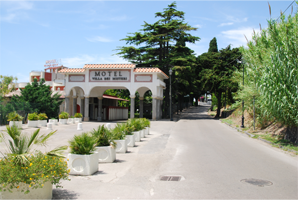
The train route to use is the Circumvesuviana and the stop is the one for Pompeii Scavi. The route starts at the exit of the train station but could equally start at the Marine Gate exit from the excavations at Pompeii (turn right) or the Villa dei Misteri exit (turn left then right on Via Diomidi). Beware: none of these roads have name boards, but you can look them up on Google Maps before leaving home. The author has included descriptions of the surroundings at important changes in direction
The walk from Pompeii Scavi station takes about 15 to 20 minutes. The author sets a brisk pace.
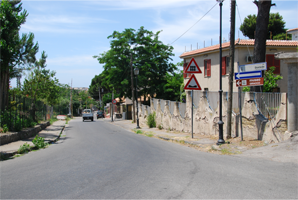
From Pompeii Scavi Station turn left and proceed along the Via Villa dei Misteri, leaving the camp site Zeus on your left. This campsite also includes a restaurant and some of the parking for Pompeii. The road proceeds up hill past the Motel Villa dei Misteri.
After the motel take the first left onto Via Diomede. This road is both signed and also has a railway level crossing visible down the road. Pass across the railway line at the level crossing and then to a T junction and right onto Via Andolifi.
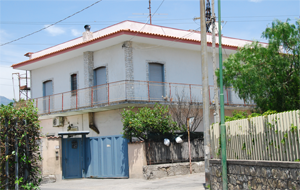
Via Andolifi does not have pavements for pedestrians and it does have traffic – be careful. Proceed back under the railway line. Just before the first of the overhead power lines (less than 100 metres from the railway bridge) turn right just before the house shown and then immediately left onto Via Grotta Peralla. The house shown was in the process of being redecorated when the photograph was taken; its appearance may change.
On the Via Grotto Peralla you should be travelling in approximately the same direction as you were on the Via Andolifi but offset a 100 metres or so to the East. Via Grotto Peralla is a quiet, narrow lane and there are agricultural businesses on your right as you walk down this road.
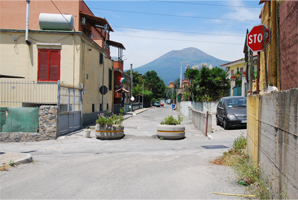
At the end of Via Grotta Peralla is a main road named Via Settetermini. On the opposite side of this road and slightly to the right is the Viale Villa Regina. Villa Regina is the name of the roman villa at Boscoreale (note: it is the modern name of the house where the Roman remains were found; we do not know what the Romans called it). It is now a residential estate having many large blocks of apartments. Proceed along this Viale; ignoring the first turning to the right onto Via Villa Regina, take the second turning. This is the far end of a road which loops through the housing estate. This road just before Viale Villa Regina turns sharply right; if you have rounded a sharp right turn you have gone too far. There are signs to the archeological site on both sides of Viale Villa Regina at the junction. Villa Regina is a hundred metres or so down Via Villa Regina, at the end, where the road turns sharply right.
There is a car park and the majority of visitors arrive by coach or car. Judging from the reactions of the staff, pedestrians visitors appear to be rare.
It should be noted that the journey described cannot be undertaken by car.
A summary of the train services is available.
Last travelled
The author last completed the journey described in June 2012.
Stabiae
Why should you go to Stabiae?
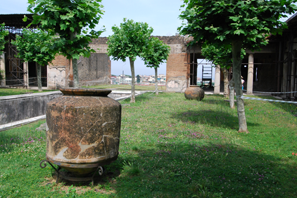
The excavations at Stabiae occupy the top of a long ridge. The buildings found so far include two large villas, parts of two other villas and the edge of the Roman town of Stabiae. There is much work left to be done and there are plans to develop this site and to make it more accessible to visitors.
In Roman times this ridge almost certainly looked out over the sea. Today the modern town of Stabiae lies at the bottom of the ridge.
The two sites which are accessible to the public are Villa Arianna and Villa San Marco. Villa Arianna is a very large villa with good wall paintings which exploited its view over the sea well. Villa San Marco is also large and it is notable for the work which the archaeologists are putting in to recovering the garden. Villa San Marco lay adjoining the roman town of Stabiae.
Both of these villas were destroyed during the eruption of Vesuvius in 79 AD, as was the town. They appear to have been overwhelmed by the volume of ash ejected by the volcano which would have crushed their roofs and covered them to a considerable depth.
How to get there
The two villas at Stabiae are relatively demanding to find by public transport and foot. A significant walk is involved. A funicular railway is planned running from the station at Via Nocera to a footpath running along the edge of the ridge which will serve all of the sites. At present (AD 2012) this remains a plan and the only way to access the sites is to walk around the hill on the existing system of public roads.
The route described starts at the station named Via Nocera on the Circumvesuviana and effectively requires a series of left hand turns to carry the walker around the side of the hill to a position above the station at Via Nocera. Having made a few mistakes on this route the author has added the GPS locations of some of the more difficult turns. Remember that, if you use a GPS, the ovoid used is WGS84; other ovoids such as that used for mapping in the UK will result in errors which will completely invalidate the locations given.
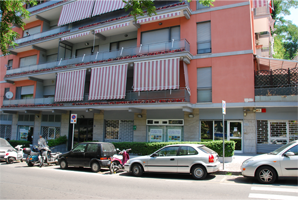
Starting from the railway station at Via Nocera, leave the station at the end marked Uscita (Italian for ‘Exit’) then turn left and walk towards the junction with Via Puglia. Before you arrive at Via Puglia you will cross the end of a small road which leads to the left. Ignore it – it provides access to the buildings behind the station. Via Puglia does not have a signboard but is a main road with heavy traffic. Turn left. After a brief period Via Puglia starts to climb and you will find a high wall on your left, initially of stone but later rendered. Continue along Via Puglia, climbing steadily, past a row of shops until, immediately after a large pink building which houses an infertility clinic, there is a turn to the left into what appears to be a blocked off road. This is the Strada Varano which becomes the Via Varano. There is a name board on the wall facing you (GPS WGS84 40 41 46.39 N 14 29 23.79 E). There is a gap between the concrete which blocks this road and the wall at the right hand side. Pass through this gap and on up the hill.
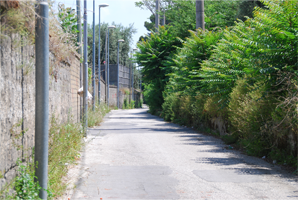
Continue on this road as it reaches the top of the hill and the sign to Villa Arianna will appear on your left just before the junction with the main road which comes in from your right (GPS WGS84 40 41 53.01 N 14 29 23.79 E).
If you are going to Villa Arianna turn left, if you are going to Villa San Marco go straight on.
The busy road is Passegiata Archeologica and you will follow it for just over a kilometre to get to Villa San Marco. As you follow it, it will join a major road, Villa San Marco is at the end of a lane 100 metres after the junction with the main road. The turning is at GPS WGS84 40 42 10.98 N 14 30 04.75 E.
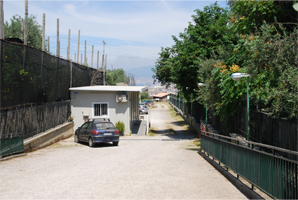
A summary of the train services is available.
Last travelled
The author last completed the journey described in June 2012.
Pozzuoli
Why should you go to Pozzuoli?
There are two sites at Pozzuoli, the amphitheatre and the so-called Temple of Serapis. During much of the Republican era of Roman history Pozzuoli was its most important port and it is probable that much still lies beneath the modern town.
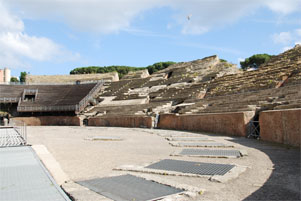
The amphitheatre was reputed to be the third largest in the entire roman empire. Today it lacks the high walls which are so characteristic of the Flavian amphitheatre in Rome but it is possible to walk on the surface of the arena and it is also possible to enter the area beneath the arena from which animals could be hoisted close to the surface and be released onto the fighting area. The spaces which would have been occupied by trapdoors for this purpose remain. It is also possible to work out how the entrances and exits for the audience were arranged and how the arena could be accessed by the staff.
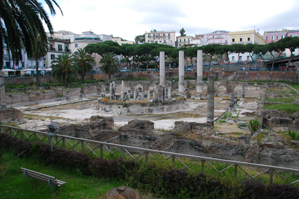
The so-called Temple of Serapis is the roman market in Pozzuoli. It is called the Temple of Serapis because the early excavators assumed that the circular pillared structure at its centre was a temple. A similar structure was found in the market in Pompeii. It contained numerous fish bones, and it seems likely that this area, in Pompeii at least, was used for the sale of fish. A provisions market in Latin is macellum and some guide books continue to use this term for the market at Pozzuoli.
The market at Pozzuoli is not a particularly interesting structure. It is not possible to walk among the remains and little more is learnt than would be available from a good guide book but if one is visiting the amphitheatre the extra distance to reach market is not that great and it is a walk downhill.
How to get there
Pozzuoli is on the slope of a steep hill. The sensible way to visit these two sites is to arrive by metro at the station, which is above the amphitheatre, to walk down to it and then on down to the sea front to see the Temple of Serapis and to return to Naples using the Cumana line, the station for which is just behind the sea front.
Take metro line 2 from any of the stations in Naples city centre, Garibaldi, Cavour or Montesanto. If using Montesanto the Metro line is not in the big modern train station; it is nearby, diagonally across the piazza. Pozzuoli is the end of the line. Leave the station, turn right and walk down hill for about 200 metres. The enormous block of masonry on your right is the amphitheatre. Walk around it to the entrance which is on the opposite side.
To go from the amphitheatre to the Temple of Serapis return to the road which descends from the Metro station and turn right to go on down towards the sea front. Proceed along the sea front until the Temple of Serapis is signed between the sea front and the railway line.
The Temple of Serapis is close to a Cumana line station which you can use to get back to Naples arriving at the smart new station in Montesanto. The Cumana line station in Pozzuoli is one block in the Naples direction from the Temple of Serapis and behind the row of buildings along the seafront.
Travellers by car should assume that parking will be difficult in Pozzuoli, there is parking adjacent to the amphitheatre but the author has not seen an empty parking space in this area.
A summary of the train services is available.
Last travelled
The author last visited the Temple of Serapsis, using the train, in 2018.
Baia
Why should you go to Baia?
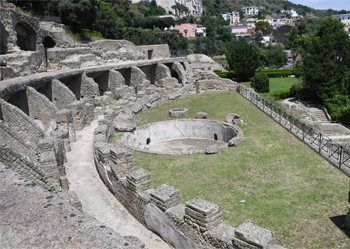
Baia, or Baiae to the Romans, was the place to which rich Romans went on holiday. It had an appalling reputation for licentious behaviour among some of the Roman writings which have come down to us but we should consider the possibility that those authors might have been jealous. It was probably no worse than the equivalent Georgian or Victorian spa town. Unlike its Victorian equivalent, the view from Baia is outstanding.
The site which survives and is open to the public is small, it is thought to comprise no more than three establishments, all of which used the naturally sulphurous, hot water which emerges from the hills behind the town. There is still an establishment in the town which uses this source of water in its spa.
It is difficult to understand the site but the northern end was definitely a bath with a large dome over the hottest area. It is unclear what happened in the central and southern sections however part of the central section appears to be a set of rooms with a sea view and it is possible that these were hired out to holiday makers so that they could bask in the sun and enjoy the view of the Bay of Naples. The site is complicated by the land having sunk by 4 metres since Roman times so that the lower sections of the excavations could not be recovered. It is possible to take a tour of that part of the town which is now underwater using a glass bottomed boat but this takes place from the port, not from the site.
This site involves a lot of steep steps, it is not appropriate for those unsteady on their feet. The site hours are 9.00 to 19.00 in summer and 9.00 to 14.00 in winter.
How to get there
The entrance to the excavations is at the top of the site and the nearest station is Fusaro on the Cumana Line. The author has advised elsewhere on this website that the Cumana Line can be erratic, in practice he has not had a single journey on the Cumana Line which has not suffered a delay or an administrative failure. It is possible that he has just been unlucky. At the time of writing (June 2018) there is a single new train on the line so things might be improving but the trains on which the author has travelled were both extensively coated with graffiti and unreliable.
It has been mentioned elsewhere on this website that, whilst the ticket office at Montesanto Station will know all of the stations on the Cumana Line, ticket offices elsewhere on the network which serves Naples quite often don’t. Whilst visiting Baia the author had to spend two and half minutes trying to persuade, in Italian, a member of the ticket office staff on the Circumvesuviana that there really is a station called Fusaro and that he really did want to travel on the Cumana Line. The author left that ticket office having been given the impression that he was not going to enjoy the Cumana Line. To be honest, that trip was no worse than any previous visit to the Cumana Line. If you are planning to visit Baia from one of the more distant reaches of the suburban system it is probably best to print off a map of the line and to mark the station on the map. We have provided a link to a map in the trains section of this website.
The station which you need is Fusaro and I strongly advise you to buy tickets for both the outward journey and the return journey when you start. The ticket office at Fusaro was closed when the author needed to return and you must have a valid ticket to ride on the train. It looked as though the ticket office was often closed. If you buy two tickets, the ticket is only valid once it has been time stamped by either an entry gate to the station or by a machine on the station, one ticket is stamped for the outward journey and the other is stamped when you start your return journey. At Fusaro the stamp machine is on the wall near the ticket office, it is orange. Normally when you visit a staion in which there is no ticket office, or it is closed, a local shop or newspaper stall will sell you a ticket, Fusaro does not have a convenient shop or stall.
The Walk
Leaving the One Way System
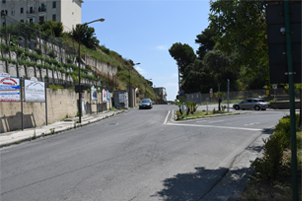
Fusaro Station is not too far from the entrance to the site at Baia but it is a steady climb up hill. The exit from the station is beside the front of the train as you come from Naples and the road leads in a very short time to a junction which is dominated by an old building with large gates. A nearby notice informs the passer that it is owned by the district of Bacoli. Turn right at this point and commence the steady but slight climb up hill. After a period of time the road will veer to the right and the climb will steepen, continue on up the road and continue straight on as you pass the Joy Cafe. At the top of this road you will see that you are at what appears to be a T junction but is actually a road coming in from the right into a one way system. Follow the one way system around to the left and then turn immediately right to continue climbing up hill for very short distance. Once you have reached the top of the hill the entrance to the excavations is about 50 yards down on the right hand side of the road. The entrance has gates and a sign.
When you have seen all that you wish to see of the excavations at Baia it is possible that you may wish to descend to the modern town in order to find some refreshment, there is a flight of steps immediately to the right of the entrance to the site as you leave which descends to the town. The car park for the port area is across the road at the bottom.
Last travelled
The author last completed the journey described in June 2018.
For the Advanced Traveller
This section includes a few of the smaller sites which are either open or are sometimes open. They are all demanding or challenging journeys from the train station. We have included them for those readers who have a specialist interest and who would appreciate a little help to find their way.
The idea for this section of the website came after the author tried to find a site starting from the wrong station, the section for advanced travellers should help others to avoid making the same mistakes.
Posillipo
Why should you go to Posillipo?
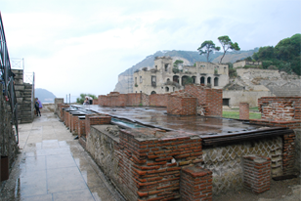
Posillipo was an imperial villa, it was left to the Emperor Augustus by Publius Vedus Pollio for the use of all future emperors. We know that the poet Virgil visited Augustus in this house and it is very likely that he stood and recited on the stage of the small theatre which can be seen on site. Augustus would have sat in the middle of the front row of seats. The position of the villa is stunning, on a headland with fabulous views. This is the villa in which Pollio, being a bit miffed that one of his slaves had broken a crystal cup whilst serving dinner, ordered that he should be fed to the lampreys which he kept in his private fish ponds. His guests were so appalled that they all dropped their food laden, gold plates into the fish tanks. Pollio felt obliged to reverse his decision. It should be noted that this story has a few variants and might not be the entire truth.
The site is massive, unfortunately only a very small portion of it has been excavated. You should not expect to see an imperial villa, just a few ruined rooms, two theatres and the most amazing views.
Another aspect of Posillipo is that it is approached by a 700 metre tunnel which is so big that it does not need the artificial lighting with which it has been fitted. This might appear to be extravagant until you recall that Roman waterproof concrete is made from pozzuoli which is a form of volcanic ash. Pollio would have needed lots of it for his fish tanks and probably took a few contracts to supply it elsewhere as well. The hill through which he tunnelled is mostly made of pozzuoli, the remainder being a limestone which is usable as building material.
Why are we not telling everyone to go there?
It is a tough journey and there are restricted opening times as a result of the need to walk through the tunnel. The tunnel is gated at both ends. At the time of writing (2022) the opening times vary with the day of the week so you need to check the website before visiting the site.
Beware: the weblink above might change and there are a number of out of date pages on the web. This is a trip for the more experienced traveller.
The journey by train and walking involves using the Cumana Line which, as I have mentioned in the appropriate place, can be erratic, there is then a mile and quarter walk to the entrance of the tunnel through a very uninteresting area. It used to be a steelworks. The 700 metre tunnel follows and there is about 300 metres beyond that to get to a relatively limited site.
How to get there
The train service to use is the Cumana Line from Montesanto Station in Naples. If you are buying a ticket in Naples then there should not be any trouble asking for a ticket to Bagnoli, which is your destination. Some of our readers will be coming from other parts of the Naples transport network, perhaps the Circumvesuviana, it is probably wise, unless you have good Italian, to print a copy of the map of the Cumana Line, we provide a link to it in the trains section of this website, and to circle the station that you want. The author once spent two and a half minutes, speaking Italian, trying to convince a ticket seller on the Circumvesuviana that the station that he wished to go to existed and that he fully understood that it was on the Cumana Line.
The station that you want is Bagnoli. Unfortunately a number of stations on the Cumana Line do not have evident signboards. If you don’t know the Cumana Line keep a count of where you are by checking off the stations on a map. Incidentally these problems do not occur if you are going to Pozzuoli or beyond. Pozzuoli is a nice place.
Leaving Bagnoli Station there are two streets across the road which passes in front of the station, take the right hand one and walk a short distance to a road which runs parallel to the sea. Turn left onto this road and proceed along it entirely across the floor of the valley in which you find yourself. As the road reaches the other side of the valley you will notice that it turns left and starts to zigzag up the side of the hill, there are steps which offer a shortcut up to the next level of the zigzag road. At the top of the second set of steps you will be facing the entrance to the tunnel. The entrance to the tunnel is enormous, you won’t miss it.
At some time in the future a revision to the railway service in this area is planned which will include a station at Coroglio, the village in the valley immediately below the entrance to the tunnel. This page will be updated when this has happened.
Bagnoli is within the Naples conurbation so that, if you are using a Giornaliero (day ticket), it will be valid for this journey.
The author was at Bagnoli in 2018 but did not walk the full journey, it being too hot on that day.
Villa Sora
Can you visit Villa Sora
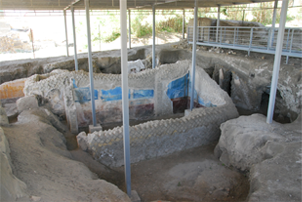
Villa Sora is in Torre del Greco and is maintained by a local voluntary organisation. It is normally closed but there are a few days during the year when it is opened by the volunteers. This note should help specialists to find it on those few days. The author found that enquiries from the public resulted in either no knowledge of the site or a vague wave in the correct direction which proved to be misleading.
Why would you want to go there
To be honest with you, you probably wouldn’t. It is a very small excavation in, what was once, an enormous villa. Your guides will tell you that the villa of which this tiny excavation is a part included a kilometre of the sea shore. During the eruption of Vesuvius Pliny the Elder set out with his fleet to rescue the trapped inhabitants prompted by a request from Rectina, wife of a prominent citizen. We do not know where Rectina lived but, if the villa was a kilometre long, and it is in approximately the correct place, perhaps this was Rectina’s house.
How to get there
The station is Via San Antonio on the Circiumvesuviana line to Sorrento or Poggiomarino. If you turn left out of station and then follow round to the right you will find that you are proceeding downhill away from Vesuvius and towards the sea. You will arrive at a main road and a roundabout. Cross it and walk on downhill on the road which is slightly to your right as you approached the main road. Effectively you will be continuing in a straight line.
After approximately half the distance that you will have covered to get to the main road you will arrive at another roundabout with a form of public park beyond it. You need to turn right onto the road which runs parallel to the sea. As you walk, on your left hand side, the park will be quickly replaced by commercial buildings. The first road to the left looks like no more than an access road, the Via del Cimitero, but you need to turn into it. A short way down this road, there is an old building on your left with an arched gateway which leads to a cultivated area, go through this arch and follow the dirt track down towards the sea. You will be walking around the edge of the field. The track turns left and then right and crosses a hummock of rough ground. The site will be seen as a sheet metal covered area to your right between the hummock and the railway line.
The author last travelled to this site a lot of years ago, before the commercial development beside the main road.
Future Development
It is planned to add more routes to this section of the website as they are explored.
We also include a brief summary of the train services which you may need to use.
